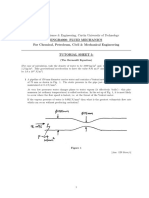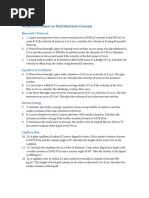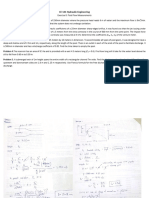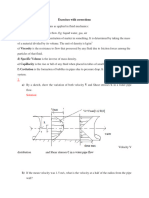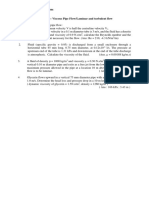Numerical_Problems_and_Solutions_Fluid_Mechanics
Numerical_Problems_and_Solutions_Fluid_Mechanics
Uploaded by
unperturbadvancementstaffCopyright:
Available Formats
Numerical_Problems_and_Solutions_Fluid_Mechanics
Numerical_Problems_and_Solutions_Fluid_Mechanics
Uploaded by
unperturbadvancementstaffCopyright
Available Formats
Share this document
Did you find this document useful?
Is this content inappropriate?
Copyright:
Available Formats
Numerical_Problems_and_Solutions_Fluid_Mechanics
Numerical_Problems_and_Solutions_Fluid_Mechanics
Uploaded by
unperturbadvancementstaffCopyright:
Available Formats
Numerical Problems and Solutions on Fluid Mechanics Concepts
Bernoulli's Theorem
1. 1. A pipe carrying water has a cross-sectional area of 0.02 m² at point A and 0.01 m² at
point B. If the velocity of water at A is 2 m/s, calculate the velocity at B using Bernoulli's
theorem.
Solution: Using the continuity equation, vB = (A_A * vA) / A_B = (0.02 * 2) / 0.01 = 4
m/s.
2. 2. Water flows through a pipe of varying cross-section. At one point, the pipe diameter is
0.5 m and the pressure is 200 kPa. At another point, the diameter is 0.25 m. Calculate
the pressure at the second point if the velocity at the first point is 3 m/s.
Solution: Using Bernoulli's equation and continuity:
v2 = (A1 * v1) / A2 = (π * 0.25^2 * 3) / (π * 0.125^2) = 12 m/s.
P2 = P1 + 0.5ρ(v1^2 - v2^2) = 200000 - 0.5 * 1000 * (9 - 144) ≈ 127 kPa.
3. 3. A tank with an orifice at its bottom is filled with water to a height of 5 m. Calculate the
velocity of efflux from the orifice using Bernoulli's theorem.
Solution: Using Torricelli's law (derived from Bernoulli's): v = sqrt(2gh) = sqrt(2 * 9.8 *
5) ≈ 9.9 m/s.
Equation of Continuity
4. 4. Water flows through a pipe with a diameter of 10 cm at a velocity of 2 m/s. The pipe
then narrows to a diameter of 5 cm. Calculate the velocity of water in the narrower
section.
Solution: Using continuity, v2 = (A1 * v1) / A2 = (π * 0.05^2 * 2) / (π * 0.025^2) = 8 m/s.
5. 5. A river has a width of 15 m and an average depth of 3 m. If the velocity of the river
flow is 2 m/s, calculate the discharge (volume flow rate).
Solution: Discharge Q = A * v = width * depth * velocity = 15 * 3 * 2 = 90 m³/s.
6. 6. Air flows through a duct of cross-sectional area 0.4 m² at a velocity of 5 m/s. The duct
narrows to an area of 0.2 m². Calculate the velocity of air in the narrower section.
Solution: Using continuity, v2 = (A1 * v1) / A2 = (0.4 * 5) / 0.2 = 10 m/s.
You might also like
- Hydraulics ReviewerDocument146 pagesHydraulics Reviewermalditaako66% (47)
- Tutorial Chapter 03 - Conservation of Energy - AnswerDocument6 pagesTutorial Chapter 03 - Conservation of Energy - AnswerMukhzin Rashid100% (3)
- ENGR2000 Tutorial A05 ProblemsDocument3 pagesENGR2000 Tutorial A05 ProblemsUD AthukoralaNo ratings yet
- Zad Cell ActivityDocument6 pagesZad Cell ActivityZaderil EstebanNo ratings yet
- Handout for Box FormulaDocument10 pagesHandout for Box FormulaplumbinstructorNo ratings yet
- HYDR 225 TUTORIAL 3 FRIDAY 20TH May 2022Document4 pagesHYDR 225 TUTORIAL 3 FRIDAY 20TH May 2022Khabane LelokaNo ratings yet
- FluidsDocument12 pagesFluidsKris TejereroNo ratings yet
- BernoulliDocument2 pagesBernoullilllllNo ratings yet
- Numerical_Problems_Fluid_MechanicsDocument3 pagesNumerical_Problems_Fluid_MechanicsunperturbadvancementstaffNo ratings yet
- MoF AnswersDocument10 pagesMoF Answersgeorgy vargheseNo ratings yet
- CIVL2611 Tutorial 12Document1 pageCIVL2611 Tutorial 12DuongPhamNo ratings yet
- Bernoulli_Solutions (1)Document2 pagesBernoulli_Solutions (1)My RoughNo ratings yet
- Hydraulics ReviewerDocument146 pagesHydraulics ReviewerKarl Anne DomingoNo ratings yet
- Basic HydraulicsDocument72 pagesBasic HydraulicsClement TakavarashaNo ratings yet
- Chapter 4 Flow Measurement and Bernoulli EquationDocument62 pagesChapter 4 Flow Measurement and Bernoulli Equationaddibzkr100% (1)
- DOC-20241208-WA0121Document6 pagesDOC-20241208-WA0121ashganm763No ratings yet
- Fluid ProblemsDocument6 pagesFluid ProblemsAlaa ShammaaNo ratings yet
- Test 2/ Exam, Fluid Mechanics For W, Vvr120 18 OCTOBER 2011, 14:00-17:00 (Test 2), 14:00-19:00 (Exam)Document8 pagesTest 2/ Exam, Fluid Mechanics For W, Vvr120 18 OCTOBER 2011, 14:00-17:00 (Test 2), 14:00-19:00 (Exam)Prashant KCNo ratings yet
- Exam 2011Document8 pagesExam 2011Bianca AsisNo ratings yet
- Tutorial 4 SolutionDocument8 pagesTutorial 4 Solutionyu yanNo ratings yet
- Unit 4 TrueDocument29 pagesUnit 4 TrueJojimar JulianNo ratings yet
- Total Marks: 100 Time: 3 HoursDocument3 pagesTotal Marks: 100 Time: 3 HoursTinashe MazokeraNo ratings yet
- CE 141 Hydraulic EngineeringDocument7 pagesCE 141 Hydraulic EngineeringAngelo Mathew ReyesNo ratings yet
- 7 Fluid Dynamics Tutorial SolutionDocument25 pages7 Fluid Dynamics Tutorial SolutionAldhaAhmadyaningratNo ratings yet
- Water ResourcesDocument1 pageWater ResourceshhhhNo ratings yet
- Fluid Mechanics - Corrected ExercisesDocument5 pagesFluid Mechanics - Corrected Exercisesug2319311No ratings yet
- Module 2 HW3Document11 pagesModule 2 HW3hgfhfghfghgNo ratings yet
- Name: Akansha Jagat Reg. No.: 18MEE0024 Course: Design of Water & Wastewater Treatment Systems Course Code: CLE5005 Slot: E1 Branch: M. Tech Energy & Environmental EngineeringDocument29 pagesName: Akansha Jagat Reg. No.: 18MEE0024 Course: Design of Water & Wastewater Treatment Systems Course Code: CLE5005 Slot: E1 Branch: M. Tech Energy & Environmental EngineeringJ. AKANSHANo ratings yet
- Hydraulic Engineering Assignment-Week 3 Number of Questions: 12 Total Mark: 12 X 1 12Document7 pagesHydraulic Engineering Assignment-Week 3 Number of Questions: 12 Total Mark: 12 X 1 12gowricivilNo ratings yet
- Tutorial 11Document2 pagesTutorial 11anishg680No ratings yet
- Che 222 Tutorial 2Document15 pagesChe 222 Tutorial 2naverfallNo ratings yet
- S06-All Examples 2upDocument5 pagesS06-All Examples 2upAvinash MeenaNo ratings yet
- WEDIII - Assignment 3 (2021) v4 (1) 5117941349308370Document3 pagesWEDIII - Assignment 3 (2021) v4 (1) 5117941349308370EUGENE AICHANo ratings yet
- Bernoullis_Theorem_Study_Note_With_ProblemsDocument3 pagesBernoullis_Theorem_Study_Note_With_ProblemsMy RoughNo ratings yet
- Prob SetDocument6 pagesProb SetXMF GamingXNo ratings yet
- Tutorial QN 6-10Document6 pagesTutorial QN 6-10clarence limNo ratings yet
- Assignment No. 2 Fluid Mechanics 2023-27Document2 pagesAssignment No. 2 Fluid Mechanics 2023-27reddymadhire40No ratings yet
- Chapter 4 Final - Flow in PipesDocument28 pagesChapter 4 Final - Flow in Pipes01fe20bme014No ratings yet
- 19 1 PDFDocument6 pages19 1 PDFآكوجويNo ratings yet
- Hydraulik RezensentDocument148 pagesHydraulik RezensentScribdTranslations100% (1)
- Tutorial 2Document5 pagesTutorial 2AndrewNo ratings yet
- FM - Assignment 2Document2 pagesFM - Assignment 2Swagata SharmaNo ratings yet
- Ideal FlowDocument30 pagesIdeal FlowCollano M. Noel RogieNo ratings yet
- TCW3101200904 HydraulicsDocument3 pagesTCW3101200904 HydraulicsTinashe Mazokera100% (1)
- Exercise Sheet 6Document4 pagesExercise Sheet 6Gonçalo GuerreiroNo ratings yet
- FlowMaster Course - Assignments - 10QsDocument4 pagesFlowMaster Course - Assignments - 10QsSezgi MaralNo ratings yet
- NUMERICAL-_hydraulics_solved_Document66 pagesNUMERICAL-_hydraulics_solved_lok.sanimahydroNo ratings yet
- EXERCISEDocument6 pagesEXERCISEJerico Enriquez CacaoNo ratings yet
- Analytical Modeling of Solute Transport in Groundwater: Using Models to Understand the Effect of Natural Processes on Contaminant Fate and TransportFrom EverandAnalytical Modeling of Solute Transport in Groundwater: Using Models to Understand the Effect of Natural Processes on Contaminant Fate and TransportNo ratings yet
- Selected Problems in Physics with AnswersFrom EverandSelected Problems in Physics with AnswersRating: 3 out of 5 stars3/5 (2)
- Exploration and Monitoring of the Continental Shelf Underwater EnvironmentFrom EverandExploration and Monitoring of the Continental Shelf Underwater EnvironmentNo ratings yet
- A Modern Course in Statistical PhysicsFrom EverandA Modern Course in Statistical PhysicsRating: 3.5 out of 5 stars3.5/5 (2)
- Enhanced Oil Recovery: Resonance Macro- and Micro-Mechanics of Petroleum ReservoirsFrom EverandEnhanced Oil Recovery: Resonance Macro- and Micro-Mechanics of Petroleum ReservoirsRating: 5 out of 5 stars5/5 (1)


